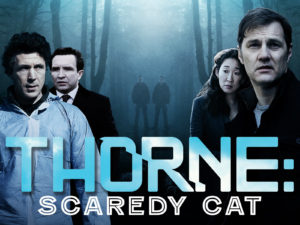Lockdown, Lowdown from Scotland: BBC TV Mini Series DI Thorne
 By Donald “Braveheart” Stewart
By Donald “Braveheart” Stewart
In series two, the Governor was joined by Cristina Yang. He had to fly solo in series one, though he did have Petyr “Littlefinger” Baelish as support. Mixing future stars from the Walking Dead, Grey’s Anatomy and Game of Thrones, was not to green light the third series but for two adapted stories it provided Thorne with an exceptional cast.
David Morrissey, playing the lead in DI Thorne, also had a nemesis. Later seen as Terry Donovan, Eddie Marsan along with Sandra Oh made an impressive grouping in an earlier time in their careers. The focus of both mysteries and crime dramas was driven by the enmity between them, but it also gave us the puzzle.
The script, developed from the first two novels by Mark Billingham, Sleepyhead and Scaredycat, the strength of Billingham’s characterization on the page transferred beautifully to the small screen. The original tale of a murderer who keeps failing by killing in the first story was inspired. For the second story, we had two serial killers working in tandem, who turn out to be more complex than they originally appear.
Produced by ITV, the British commercial channel, Thorne was a triumph in terms of adding to the cannon of quality screen adaptations and gritty real life drama, but it also featured camera work that marked it out. The angle at which we saw this plot unfold was always putting the hero, Thorne in the spotlight. We may be used to maverick cops, but this one came with added danger and a specifically dodgy edge. He was not just out on a limb, he was close to getting canned continuously. He also had strange bedfellows.
Having read the books, there were more than a few major positives in these adaptations. They kept close to the original narratives which had been brilliant to read. Billingham’s writing style where the twists and turns involved his main character and his flaws may not be the most original trope but here it felt fresh and given that this was broadcast over ten years ago, it still feels like that now.
Thorne, an outcast who was intuitively brilliant, has an odd relationship with his pathologist, Phil Hendricke. It was the first time that I had seen an openly gay character in a major role, and unfortunately with a straight man in the role, Petyr “Littlefinger” Baelish from Game of Thrones/Tommy Carcetti from the Wire, Aiden Gillen. Retaining the character as he was in the books made it all the more worth watching! In the first series and in the first book, Thorne and Hendricke, who are flat mates, fall out spectacularly as Hendricke ends up being arrested for the murders.
Added to the retention of the openly gay lead, the series also changed the sex of one character and the ethnicity of another to give the whole enterprise some form of balance.
We can now get the whole series online in the UK, and when it went to the States it was Encore who took charge of broadcasting over two nights – the whole two stories. They made us wait over six whole weeks!
How the whole thing came about is worthy of note. Morrisey had found himself the chosen Thorne after reading a Billingham novel whilst filming in New Zealand. Impressed by what he read, he searched for Billingham online. What he discovered was a question and answer session where, when asked who he would like to play Thorne if it was ever made into film or television series, Billingham maintained he would like Morrissey.
Slum dunk right there then!
Both Morrisey and Billingham had wanted to continue the televisual adaptations – there are quite a few more novels available for adaptation. The problem became, as it often does, alternate shows and schedules as Morrisey landed the part previously referred to – in the Walking Dead – and Thorne became the walking wounded that was unable to recover.
But what we have… well… it’s worth a look again, and again…
British television is a curious affair. Begun through the British Broadcasting Corporation (BBC) it is funded through the universal license fee. In essence, if you wanted to watch the television , you had to pay the license fee. The BBC got it all and is state run, albeit at arms-length. Then came along commercial television in the form of the Independent Television (ITV) in 1955. Designed to bring a bit of competition to the BBC, it was paid for through advertising but still free to air… well they didn’t add another license fee to it. By the time that I was born, 1965, there was BBC1, BBC2 and ITV. And that was it. It was still years before Bruce Springsteen would moan that there were 55 channels and nothing on but here in the UK, we kept this going until in 1982, we added a fourth channel and in 1997, a fifth. With sparkling imagination, they were called Channel Four and ehm Channel Five… In between came Sky and we understood what Springsteen meant. And so, my childhood and leading up to early adulthood we had three options… But the programs made were exceptionally good. And so, here is some critical nostalgia as the lockdown has brought a plethora of reruns, new formats and platforms and old classics trying to make their way back into our consciousness as broadcasters flood their schedules with classics… or are they classics at all? Let me take you through an armchair critics’ view of what we have to see, to find out… Welcome to the Lockdown Lowdown…
[si-contact-form form=’2′]

